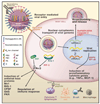The influenza virus enigma
- PMID: 19203576
- PMCID: PMC2971533
- DOI: 10.1016/j.cell.2009.01.029
The influenza virus enigma
Abstract
Both seasonal and pandemic influenza continue to challenge both scientists and clinicians. Drug-resistant H1N1 influenza viruses have dominated the 2009 flu season, and the H5N1 avian influenza virus continues to kill both people and poultry in Eurasia. Here, we discuss the pathogenesis and transmissibility of influenza viruses and we emphasize the need to find better predictors of both seasonal and potentially pandemic influenza.
Figures


References
-
- Alexander DJ. An overview of the epidemiology of avian influenza. Vaccine. 2007;25:5637–5644. - PubMed
-
- Beigel JH, Farrar J, Han AM, Hayden FG, Hyer R, de Jong MD, Lochindarat S, Nguyen TK, Nguyen TH, Tran TH, et al. Avian influenza A (H5N1) infection in humans. N. Engl. J. Med. 2005;353:1374–1385. - PubMed
-
- Belser JA, Lu X, Szretter KJ, Jin X, Aschenbrenner LM, Lee A, Hawley S, Kim do H, Malakhov MP, Yu M, et al. DAS181, a novel sialidase fusion protein, protects mice from lethal avian influenza H5N1 virus infection. J. Infect. Dis. 2007;196:1493–1499. - PubMed
Publication types
MeSH terms
Substances
Grants and funding
LinkOut - more resources
Full Text Sources
Other Literature Sources
Medical
Miscellaneous

